110 film
This article concerns the 1970s cartridge film. See the Category: 110 film.
There was also a roll-film size designated 110, from the turn of the 20th century.
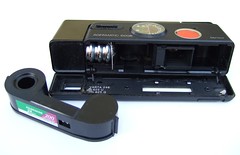
|
| Typical 110 cartridge & loading slot, on an Agfamatic 6008 image by Uwe Kulick (Image rights) |
Contents
Specifications
110 is a cartridge film format introduced by Kodak in 1972. The 110 frame size is 13 x 17 mm (0.51 x 0.67 in).[1] There is one registration hole per frame. The film is paper-backed, with frame and film type information visible through a window in the plastic cartridge. 110 film includes pre-exposed frame lines and frame numbers.
History
110 and 126 film cassettes were launched by Kodak in answer to consumer complaints about the complications involved with loading and unloading roll film cameras. With the cassette film you don't have to attach the film leader to a take-up spool and cannot go wrong. The cartridge simply drops into the camera, you close the camera's back door, wind on and shoot. Even if you open the camera with a half exposed film inside, the precious exposed film is well protected inside the cassette. And at the end of the film, you don't have to rewind.
After the success of Kodak's 126 cassette "Instamatic" cameras, 110 was introduced in 1972[2] to take advantage of improvements in film allowing smaller format negatives. The first Kodak cameras being branded "Pocket Instamatic".
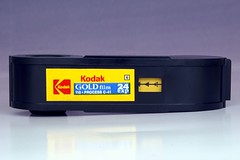
|
| 110 cassette label and frame number window image by Kenneth Dwain Harrelson (Image rights) |
The 110 cassette contains 16mm wide film, with one perforation at each frame which engaged with a pin beside the film gate to control the film advance. Like 126, 110 film is pre-exposed with a border and frame number between the frames. The film is paper-backed; the paper being printed with frame numbers, visible through a small window in the cartridge's rear; a larger window in the film chamber door shows this frame number window plus a label on back of the cartridge giving film details.
The small dimensions allowed designers to create small pocketable camera that had an aspect very different from the traditional 35mm cameras, even if they had a marked resemblance with the older sub miniature 16mm cameras. The pocketability and ease of loading made 110 popular very quickly. The design of the cassettes had a very basic system of notches in a tab on the end to indicate film speed, but few cameras took advantage of this, and many film cassettes did not even have the required notches.

|
| Scan of a 110 frame (Negative Inverted) showing the sprocket holes and frame number markings image by Martin Paling (Image rights) |
As the majority of 110 cameras were extremely simple - with a few notable exceptions such as the Rollei range and the Minolta and Pentax SLRs. Most 110 cameras had a single shutter speed and aperture setting and no focusing available, the success of getting prints from these tiny 13x17mm negatives relied on the latitude of the film. Even with today's modern film emulsions and an accurate focusing and exposure mechanism it would be tough to get much more than a 5×7in print from such a tiny negative. Disappointing print results were the main downfall of the format.
As with 126 cassettes, the design of the 110 film cassette itself relegated this format to a strictly amateur market. As with 126 cassettes, a major drawback of the cheap plastic cassette format is that the film transport mechanism is contained almost entirely within the cassette, which is generally constructed to low tolerances with significant play in many of the key components. The cassettes themselves also fit relatively loosely into the camera bodies. These loose tolerances make it virtually impossible to maintain precise film positioning, particularly in the film plane. This in turn makes it impossible for higher end cameras to create consistent high-quality images, regardless of the quality of components or designs of the cameras themselves. Therefore, the vast majority of 110 cameras produced images of lower quality than other 16mm film subminiature cameras that had come before.
Kodak discontinued all 110 slide films in 1982.[3] Kodak stopped making 110 cameras around 1994[2], with few other manufacturers' 110 ranges lasting any longer. 110 negative film continued to be made by Fuji until September of 2009[1], and by Kodak and Ferrania for a few years more. It later resumed production (see below).
In 2010, Fotoimpex (under the Adox brand name) investigates the feasibility of producing 110 film.[4] In 2011, their web page was updated that stated backing paper and film cassettes have been produced. In 2012, the factory is being retrofitted and plans are underway to reintroduce the format.
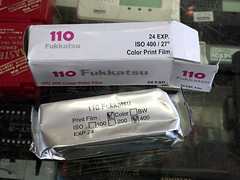
|
| image by Mark Dalzell (Image rights) |
In 2012, a resurgence of 110 film started when a small Hong Kong based company Films Reborn released small batches of Fukkatsu 110 film in 100 ISO black & white and 400 ISO colour for direct distribution in spring of 2012. During this time Lomography also released their Orca line of black & white film.[5]. Lomography's initial batch of films did not contain the backing paper. A couple of months later they also introduce another film called Tiger which is a 200 ISO C-41 colour film. A few months later in Jan, 2013 a 200 ISO colour slide film called Peacock was announced.[6] Lomography also sells a redscale 110 film.
With Lomography now making it, 110 film has outlived two formats intended to replace it, disc film and APS film.
Gallery

|
| Simple: Kraft Velveeta promotional camera image by Hillary Stein (Image rights) |

|
| Fex-Indo Pocket 110X image by Gilles Péris y Saborit (Image rights) |

|
| SLR Pentax Auto 110 image by Neal Wellons (Image rights) |
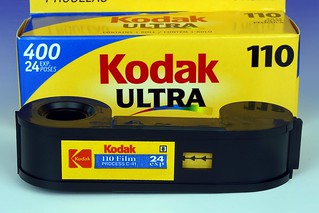
|
| 110 film cartridge image by Kenneth Dwain Harrelson (Image rights) |
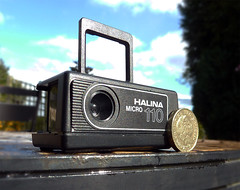
|
| The Halina Micro 110 belongs to the most primitive toy cameras. It has just to be clipped onto the film cassette. image by bigalid (Image rights) |
Notes
Links
- ISO Standard 12450: 110-size cartridge, film and backing paper at ISO.org
- US Patent 3581641: Film Cartridge and Camera
- Splitting Film at Subclub.org
- Reloading 110 Cassettes at Subclub.org
- Reloading 110 Cartridges (archived) by Mark Hahn
- 110 film still available at the frugal photographer (archived)
- 110 Cameras page at Collection G. Even's site (in French)